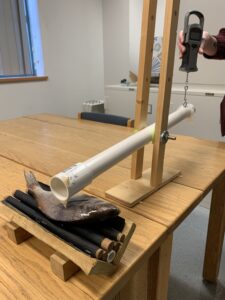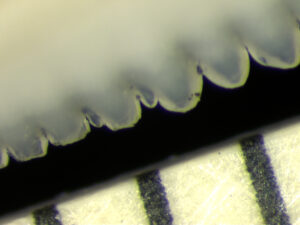Allegheny Student’s Research Puts Teeth in the Mighty Bite of the Shark

Meadville, PA – It’s roughly 350 miles from the Allegheny College campus to the frothy, shark-infested waters of the Atlantic Ocean, but that didn’t stop Ryan Sesler ’23 from pursuing his passion for marine biology and studying the notorious marine creatures.
Sesler’s senior project research was centered around the hypothesis put forth by his advisor, Dr. Lisa Whitenack, that sharks replace their teeth on the basis of wear and tear, not just when they lose them.
Sharks have an endless supply of teeth that regenerate constantly throughout their lives. For example, according to Smithsonian magazine, a great white shark can go through 20,000 teeth in a lifetime.
“We’ve been wondering for a long time on why sharks shed their teeth so often, and Ryan’s work sheds some light on the subject – the more teeth are used, the duller they get, and the harder the shark has to bite into its prey,” says Whitenack, who is an associate professor of biology. “This also opens up a whole other suite of questions to explore as we keep picking away at the fundamental question of why sharks shed their teeth.”

Sesler, who graduated summa cum laude in May 2023 with a biology major in marine sciences and a music performance minor in voice, focused his research on the biomechanics of shark teeth and how repeated punctures, or “bites,” taken by a shark impact the shape and cutting efficiency of the teeth. He used teeth from a bull shark, sandbar shark, blacktip shark, great hammerhead, and a short-fin mako. He obtained the shark teeth from Dr. Whitenack’s collection.
He subjected 25 teeth, five from each species, to 400 punctures and measured the wear and tear that was occurring to the edges and tip of each tooth, along with recording how the puncture force changes as the teeth wear down.
Sesler’s findings showed significant amounts of wear occurring to the shark teeth with each bite or impact. His results supported Dr. Whitenack’s hypothesis that shark teeth are replaced quickly upon dulling and supplied quantitative evidence for puncture wear on a shark’s teeth.
“My major takeaway from this project is how even though Allegheny is hours away from the nearest ocean, I was still able to pursue research in marine biology,” says Sesler.
Sesler was able to do internships in marine biology during his time at Allegheny. He was a research scientist for the Coastal Marine Education and Research Academy in Clearwater, Florida, during the 2020 and 2021 summers where he assisted in catching, tagging, and releasing wild sharks and rays.

He also studied away at the Duke University Marine Lab in Beaufort, North Carolina, during his junior year and took specialized marine biology classes and conducted research on southern stingray population dynamics in the U.S. Virgin Islands.
After graduation, Sesler went to the Brinton Environmental Center and is currently working at the Boy Scouts of America Florida Sea Base in Summerland Key, Florida. He is a Marine STEM educator and spends his days conducting coral nursery husbandry, tagging wild sharks, and out-planting coral during scuba dives in the Florida Keys.
Sesler says it would be a dream come true to eventually be a professional aquarist at a major aquarium.
“Throughout my time at Allegheny, I discovered that working with animals such as sharks and rays is truly what I am passionate about and I want to teach others about these amazing animals,” he says. “When I was a child, the best part about the aquarium was seeing the tank divers wave from inside the tank. Now, I want to be that person waving from inside the tank to the next generation of marine biologists.”